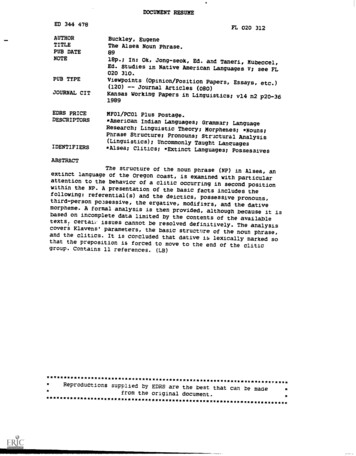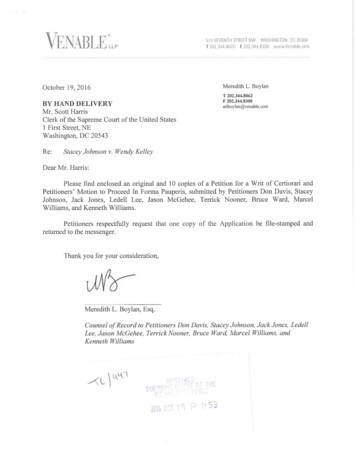
Transcription
DOCUMENT RESUMEED 344 478AUTHORTITLEPUB DATENOTEPUB TYPEJOURNAL CITEDRS PRICEDESCRIPTORSIDENTIFIERSFL 020 312Buckley, EugeneThe Alsea Noun Phrase.89lep.; In: Ok, Jong-seok, Ed. and Taneri, Mubeccel,Ed. Studies in Native American Languages V; see FL020 310.Viewpoints (Opinion/Position Papers, Essays, etc.)(120) -- Journal Articles (080)Kansas Working Papers in Linguistics; v14 n2 p20-361989MF01/PC01 Plus Postage.*American Indian Languages; Grammar; LanguageResearch; Linguistic Theory; Morphemes; *Nouns;Phrase Structure; Pronouns; Strlctural Analysis(Linguistics); Uncommonly Taught Languages*Alsea; Clitics; *Extinct Languages; PossessivesABSTRACTThe structure of the noun phrase (NP) in Alsea, anextinct language of the Oregon coast, is examinedwith particularattention to the behavior of a clitic occurringin second positionwithin the NP. A presentation of the basic factsincludes thefollowing: referential(s) and the deictics,possessive pronouns,third-person po3sessive, the ergative, modifiers, and the dativemorpheme. A formal analysis is then provided, althoughbecause it isbased on incomplete data limited by the contentsof the availabletexts, certail' issues cannot be resolved definitively.The analysiscovers Klavens' parameters, the basic structtlre ofthe noun phrase,and the clitics. It is concluded that dative islexically marked sothat the preposition is forced to move tothe end of the cliticgroup. Contains 11 references. *************************Reproductions supplied by EDRS are the best that can be madefrom the original ******************************
"PERMISSION TO REPRODUCE THISMATERIAL HAS BEEN GRANTED BYDE DEPAATINENT OF EDUCATIONOffice of EducaNceel Rusaterl Arte ImormementEDUCATIONAL RESOURCES INFORMATIONCENTER (ERIC)iiMa document Ass been reProduced aswaved horn the person or argent:shortomprtatmg itCI Minos cganpes rtaye been mute to Improvereproduction outlayTHE ALSEA NOUN PHRASETO THE EDUCATIONAL RESOURCESINFORMATION CENTER (ERIC)"Pants of veer or opinions stated in tots clocu-merit do riot necossarry represent officio;Eugene BuckleyOEM 'gagman or pokeyAs.tairssluslisaThis paper examines the structure of the noun phrase in Alsea, an extinctlanguage of the Oregon coast, with particular attention to the behavior of aclitic occurring in second position within the NP. I will first present thebasic facts and then consider an appropriate formal analysis. Sirce thisanalysis is based on incomplete data limited by the contents of the availabletexts, there are certain issues which cannot be resolved definitively. Thebasic facts, however. are clear and interesting enough to warrant an attemptat a formal treatment)1.TILL-22111LxhaistThe Abet noun phrase has the following basic structure, where It) andare elements which will be explained later:(a)DETERMINERmodifier-it)IS)Isi-nounThe determiner further has the following composition:(b)DEICTIC-REFERENTIALIn addition, the entire phrase may be preceded by an ergative case markerThese elements will be discussed in the sections below.1,1 The reervaial le and the deicticsuse:A noun can occur by itself; generally this is in a nonreferential, generic(1)p-strwilt-uwitx-ayu.-sx-am2p1S-wind TRL-become-TRL-REFL-INTRTurn into winds!' (34.1)By far the most. common case, however, is to have both a deictic and thereferential present. There are three deictic prefixes relevant here, of theforms lal. (kul, and Its, tel. They indicate the position of the noun in physicalçtspace but also seem to serve discourse functions as well; since their precisemeaning is not important for the present purpose, they will all be glossed DEI.Following the deictic element is the referential Isl. Together they form adeterminer which precedes the noun:(2)0tanys-x ku-scu-tityssee-CMPL DE1-REF salmon'He saw a salmon: (106.10)C'4Kansas Working Papers in Linguistics, 1989, Vol. 14, no.2, pp. 20-36.2RFST MPY AVAP ARV
21(3)4-ti.wiThwan-tn-xta-sDE1-REF arrow TR-make-PASS-CMPL'Arrows were made. (40.22)Occasionally a noun is found without the referentialmarker.a story.but with a deicticOften these examples are in quoted speech and refer to characters inIt is assumed that this omission serves some pragmatic function, sinceunder normal circumstances an object must be referential in order for itslocation in space to be sgS DE1 sea.otter'I refuse (to marry) that sea otter!' (92.13)There are also a few examples of the referential NJ without a deictic. This mayat times be a reduction of Iasi, but in some cases such as (s-lahwil 'the world,the earth'. the vowel is nearly always omitted and the entire phrase may belexicalized. In this particular csse it seems reasonable to omit the deicticsince 'the earth' is always in the same place.Deictics can also be added directly to emphatic pronouns, though this useis not tommon since the position of, say, the speaker is generally obvious.(5)to-qnincrim-im-tx-amis-inFUT-IsgS behind-DUR-HAB-INTR DEI-Isg'ill walk behind' (158.21)In this context the deactic is probably motivated by the emphasis of thespeaker on his physical location1 2 The possessive nroriourlIn all of the examples above, the referential (s) can be replaced by a firstThe possessive pronoun and theor second-person possessive pronounreferential never cooccur, presumably because for a thing ta be possessed itmust be referential (i.e. the NP must have a specific referent). In otherwords, the possessive pronouns are really more specific variants of thereferential.ci.s-tuxs(6 )DEI- I pIP Ivin-COLL'our winnings' (26.17)(7)qi lintDEI-2p1P younger .sister'your younger sister' (22.10)Often the possessive pronoun occurs without any deictic, probably becausethe indication of the possessor is usually sufficient to identify the referentwithout specifying its location.(8)sinsi 'ye?IsgP leg'my leg' (72 31)3
22Li.alle--lhiLit:122 2.11.2211113AY.1The remarks above with regard to the first- and second-person possessivepronouns are largely true of the third-person possessive circumfixThe initial element ici appears prefixed to the noun, while the final 41appears suffixed to the noun. Most frequently there is no deictic:(9)c-hty-jrPOSS-inind-POSS'his mind' (86.13)It appears that historically the initial Ici may come from the deicticreferential Rasi, but synchronically this (c1 is simply required in order tomark a noun as possessed by a third person. Interestingly, though, it seems tohave retained its referential meaning and is thus parallel to the possessivepronouns: no referential Is; cooccurs with either of them. Thus one finds thesimple deictic, including the possible cognate Itoi. attached directly to Id(10)ku-e-tijcDE I -POSS-father-POSS'his father (70.14)(II)DEI-POSS-head-POSS'his head' (120.25)If a noun indicating the possessor is present, then it generally occurs beforethe possessed noun (which is marked with the circumfix). Ir this case thereferential Is) does appear at the beginning of the.NP, but it seens to refer tothe possessor and not the entire NP. This is because the head of the NP isalready marked as referential by toi:(12)II a-sximni IfDE I-REF whalec- squsin-,11POSS-skin-POSS'the whale's skin' (80.8)Evidence that the initial deictic and referential refer only to the adjacentnoun and not the whole NP comes from structures where the possessorappears after the possessed noun, in which case it is possible (but notnecessary) to get deictic markers on both nouns:(13)11 ku-sPOSS-actions-POSSckitins 1DEI-REF crane'the crane's actions' (72.36)(14)1a-c-meta.nistiyu.-k-isx IDEI-POSS-chief-POSS-PLIs-stayi.cit IDEI-REF villager'the chief or these villagers' (228.6)The correct generalization seems to be that if the possessor precedes the head,then the NP as a whole is not marked with a deictic if the possessor follows,then the head (and therefore the whole NP) can be marked. This restrictionmay be related to the proposed origin of ici as a deictic and referentialdeterminer. Note the similarity to the possessive pronouns, which also
23generally occur without a deictic: the same explanation, that they aresubtypes of the referential, plays a part with the third-person possessive asWith multiple possession the head comes to the right or its complement ineach case:III I I c-414-itI c-cri23-#(13) III ku-sPOSS-head-POSSPOSS-son-POSSDEI-REF SukuSukuli son's head' (72.21)Here again the determiner Ikusi seems to refer lust to the dependent noun(s'Crku) and not to either of the possessed nouns. Unmodified nouns(including proper names) have a general requirement for a determiner.while nouns with Ic.tI are already determined: thus the (kus1 must refer toSuku, and must not refer to the other nouns. Compare the following example.where the possessive pronoun 'my' cletrly must refer only to the firstinstance of 'father, because the second (the head of the NP) is possessed bythe first:(16)sints*7I sgP father POSS-father-POSS'my father's father' (j66.38)Since the referential and the possessive pronoun are in parallel structures inall ways examined so far. it seems reasonable to argue that in (12) and (15) aswell the two are parallel and both modify the immediately adjacent N. not thehigher argument NP.I 4 The ereativeNouns which serve as the subject of a transitive verb are preceded by theergative marker km sal This proclitic can occur with or without a deictic,but when it is used with a nonpronominal it (like deictics themselves) alwaysseems to combine with the referential Is) or one of it: possessive substitutes(17)(18)iimxad-uERG-DE1-lsgP child-PL'my children' (86.17)laqusinERG-DEl-REF skinqa-10-s'the skin' (80 14)Like a deictic. the ergai.ive can be added directly to a pronoun. possessive IcI,possessive pronoun, and referential(s)qtimhatERG-lsgP brother-in-law'my brother-in-1m (118 3 1 )(19)xe-sin(20)qa-c-miihscERG-POSS-boy-POSS'her son' (214.10)5
24(21)qa-nUxERG-2sg'you' (45.29)(22)hitslamqa-sERG-REF person(you) people' (46.13)It may be correct to say that the ergative always occurs with a deictic, sinceinstances of Nal are phonologically ambiguous between the simple ergativeon the one hand and the ergative and an elided deictic (al on the other. Notenough is understood of the use of the deictics to give direct contextualevidence for or against the underlying presence of the tal in such cases.The ergative comes at the beginning of the NP and not before the head,though of course ergativity is the property of an argument and thus of theheed. not some REF earth.people POSSchild-PL-POSS'the children of the earth people (104.18)(24)xi m'-atqa-sERG-REF one-ADJ CSTR-canoe'a certain canoe' (166.10)In (23) the ergative (sal refers to the entire NP, which is the subject of thesentence, while it seems best to say that the referential Es) refers to theimmediately following noun, as discussed above. In fact, the underlyingrefers to 'earth people' and /za,/,structure may be isa-a-si. where thewhich is procliticized on the entire phrase, refers to the argumentNP'children of the earth people'.LiaiggiLienThe label 'modifier' given at the beginning of this paper refers toadjectives and numerals and occasionally nouns. The numerals (which seemto be a subclass of adjective) are always followed by the adjectival suffix I-13when in attributive position. Adjectives used attributively generally also takethis suffix but not always; the conditions determining its occurrence are notentirely clear to me. but it appears to be a lexical property of the adjectiveitself.In addition to the adjectival It) which is suffixed to the modifier, there is aformative Isi which appears prefixed to the following noun. This Isi can befound even when the [ti is absent. It is homophonous with the referentialmarker, and may historically be related to it, but since the two can ceoccur,and are found in different places, it seems unreasonable to call them the sameNote, however, that a modified noun often occurs without amorpheme.determiner, a fact which may be a result of this historical origin (more onthis in section 3):6
25(25)xim'-atone-ADJs-hitalamCSTR-person live-CMPLThere once lived a certain person.' (j72.19)(26)s-mishilyt-uku-sDEI-REF two-ADJ CSTR-old.man-PLThe two old men' (72.22)(27)11-skOlu-tocean-ADJ CSTR-vater'the ocean water'The last example shows a noun used as modifier; this is much less commonthan the adjectives exemplified in (25) and (26). I have glossed the Isi as CSTRfor construct, since its function is similar to that of the Semitic consul -tstate, which marks a noun as being 'in construct with' a dependent noun.The Alsea morpheme indicates that the head noun is modified by thepreceding word - whether adjective or noun.Although in nearly every example this fil occurs before a noun, this maybe an accidental result of the fact that all the nouns have just one modifier.The one example I found of a noun with two attributive adjectives shows asomewhat different situation:(28)s-ma7s7qayt-ithigh-ADJ CSTR-rich-ADJ CSTR-person'a rich person living in the sky' (228.27)qiwx-atIt seems here that the clitic is) is relatec to the adjective preceding it ratherthan to the word following it, which can be either a noun or anotheradjective. This notion receives support from the fact that certain modifiers(i.e. quantifiers) do not occur with this fsl. though they do occur with thereferential is) found with deictics:(29)meqamin-t hitsiammany-ADJ person'many people' (j66.2)(30)hamsti-7-t.x incis(31)hamsti.7 hi-tslamqa-spersonERG-REF all'all the people' (54.20)all-ADJ-2sgS thing'You (have seen) everything' (182.21)The modifier Is) might thus be argued to be the type of chile described byKievans (1985) which is syntactically dependent on the previous word butphonologically dependent on the following I will claim later. however. thatthe construct analysis is correctThe modifier of the noun is considered a separate constituent for theplacement of a second-position sentential :laic, such as those marking the7
26subject. That is, these clitics occur after the first word or the sentence, evenif this involves splitting an argument:(32)s-milhu.diysxiinl-t-etone-ADJwe CSTR-tribe'We are one tribe.' (204.29)(33)qa-sMk-et-saxs-hi.tslamERG-REF two-ADJ-3duS CSTR-person'two people [kept hitting the grass!' (46.7)See also (30). Examples such as these, as well as the fact that they do notalways cooccur. motivate the separation of Cti and Is1 into differentformatives, even though both are present due to the preceding modifier.The possessive prefix fci patterns with the construct Is) in that it isprefixed to the noun: for this reason modifiers precede it. Note that when theprefix (el is present the construct Is) is absent:(34)i.s(35)qalpiyiat-itc-actiyslcin one-ADJ POSS-sleeping-POSS'during one of his naps (174.23)next-ADJPOSS-meeting-POSS'their next meeting' (108.32)This situation is parallel to the referential Es) which also cannot directlyprecede the possessive prefix.Due to the limitations of the data available for Alsea, there is no goodevidence for deciding whether the first and second-person possessivepronouns belong to the same pattern as the construct is) and possessive faThat is, it is impossible to say for sure whether an adjective would precede orfollow the possessive pronoun. In his field notes at the Smithsonian,Frachtenberg gives the following constrast (the parse is mine):(36)qan-1-salsin(37)qanist-it sintr.?ta.?die-INCH-DSTR IsgP father'My father is dead:dead-ADJ I sgP father'my dead father'The first example, (36). I would translate 'My father died (long ago)', since thedistributive suffix /sal/ is used to mark the remote past and the perfect aspect(Buckley 1986). At any rate this is definitely a verb-subject construction. In(37) the situation is not so clear. I am confident that the first word is anadjective, but it is not clear that thir is a noun phrase. Frachtenberg puts aquestion mark next to these two sentences as though he is not sure of thetranslations. Since there is no copula in Alsea, the adiective could easily bepredicative rather than attributive, in which case (37) would be a sentence
27meaning 'My father is And.' Thus it is difficult to be certain whether (37) iseven relevant to the present discuss'on.In the published texts, there Is no clear example of an attributivemodifier and possessive pronoun cooccuring, except for the quantifier 'all'which is free to float outside the NP anyway:(38)ham.sti.?sinhilslamI sgP personall'all my people (214.10)While in (31) above the quantgier follows the determiner as would a normaladjective, the opposite order is equally possible:(39)hamsti*?qa-s1111slamERG-REF personall'all the people' (54.17)Given this ability to float, the position of the quantifier in (36) does not tell usanything definitive about the possessive pronoun.One other construction might be interpreted as evidence that thepossessive pronoun follows modifiers:(40)i's yiirwi-s fin kini.sayt'to ownIpIP neighbor'towards our own neighbors' (184.13)(41)icini-isyt'yisxwi.s sin1sgPneighborown'my own neighbors' (184.15)Here the element Iytixwi'si precedes the possessive pronoun.But again, thesignificance of this fact is unclear since brim/ill is not a typical modifier. ittakes no It1 suffix here, and has the internal morphology of a noun. I havealso found no examples of ()quail) serving as a modifier of a noun with adeictic-referential determiner, with which (40) and (41) could be compared.One fact argues in the opposite direction, that the possessive pronounspattern like the referential [4 and should precede modifiers: thetranscription that Frachtenberg uses. He writes both the possessive prefix I cland the construct Is) as part of the word that follows - consistent with thecommon syntactic patterning described above - but the deictic-referentialdeterminer and the possessive pronouns as separate words, suggesting thatperhaps they pattern together as well.Since they are also found with(secondary?) stress as in (17) they are unlikely to be prefixes on the noun: Ithink they are probably clitics which occur at the beginning of their nounIt may be that there are other examples in Frachtenberg's notesphrase.which bear on this issue, but for the time being I will assume that thepossessive pronouns pattern with the referential.
28There is a dative morpheme WI, most often indicating rotion towards thenoun tallativel. which, in an unmodified noun phrase, occurs directly afterthe noun. Note that this is the situation whether there is just a noun, or anoun with a determiner:(42)nt's.ajcs2spDAT'for you' (174.2)(43)tayi.cit-etsvillage-DAT'to a village' (34.24)(44)sin(45)2-3i.cays-iicsIsgP house-DAT'home, to my house' (220.1)pirDEI-REF boat-DAT'into the boat' (220 21)One might conclude from such examples that 451 appears at the end or the NPand is a postposition. When a modifier is present, however, the dative occursafter that modifier instead of after the noun:s-milhirdiysci.ms-t-ilcsRES go-INCH-INTR different-ADJ-DAT CSTR-tribe'so he would go to different tribes' (34.15)ay-iy-m(46)Icis(47)gig ay-Iy-m(48)xim'-t-its.II qahil-tss-fayicit1RES go-INCH-INTR different-DAT CSTR-village'so he would go to a different village' (34.22)lahwf.one-ADJ-DAT place'to one place' (46.11)In an NP where the head noun is preceded by a possessor NP, the dative comesafter the possessor:(49)ku-h am t1-ica-itx2DEI-your father.DAT-PL POSS-sweathouse-POSS'to your fathers' sweathouse' (130.29)Note that in (49) the movement is toward the sweathouse. not 'your fathers',even though the dative comes after the latter element.There is no example of a modified noun with both a determiner and thedative present. This is not terribly surprising since neither the determinernor the dative is found very frequently with a modified noun in the firstplace. Still, due to this gap in the data we cannot be absolutely certain that inan example such as (26) the dative would come after the adjective instead of
29after :he determiner or even somewhere else. But given the behavior of thedative ia (45) and (49), where the determiners are ignored for the definitionof 'second position', it seems safe to suppose that the dative would in fact comeafter the adjective in (26). 1 will make this assumption in my analysis.2 1 AdvertiaIt is not clear what role adverbs play in the noun phrase. The dative hasnot been found together with an adverb in attributive position before a noun:the few examples available are with locative adverbial,. There the adverb(ci-mal 'very (much) seems to be ignored for the placement of Its):(30)Mica I cilium ni.sk-ipjustvery far-DATJ ay-iy'he vent very far (163.9)go-1NCHBut ki.ma1 is also found completely separated from the phrase it modifies.making it unclear where it should be positioned in the structure:(51)ni-sk-Ms hlka caws ay-iyjust very go-1NCH'he went very far' (168.15)far-DATThe same facts relative to fis! seem true of another adverbial modifier.'a little':(52)zersi-clawzin- jcsclittle above-DATThe moved] a little higher' (76.35)Since the adverb in many cases occurs rather freely separated from what itseems to modify (similar to the quantifiers), and since these examples areadverbial and not nominal, I will not attempt to incorporate them into myanalysis. A phrase such as 'to the very big house' would be necessary todetermine with any certainty the behavior of these .ral There is a common clitic fawkcJ 'in. inside' which seems to have severalpossible domains: S. V. and NP. Although it is clearly attested in only oneexample, it appears that (awki can behave like fg. ) when it is prepositional(53)zinact-awtone-ADJ-in CSTR-year'for one year' (120.26)This clitic shows up in the same position as the dative, and can be analyzed inthe same way.3tinityiLsI will now offerformal analysis ot the data discussed aboveUnfortunately it cannot be pursued with complete thoroughness because thedata necessary to check the validity of certain predictions are simply nota11
30available in the existing corpus. Still, it should useful to try to formalize whathas been described.It I Mavens parametersIn the typology of clitics in Klavans (1985), it is possitie to specify thebehavior of a clitic with three parametertPI) Dominance - whether the clitic is positioned relative to the initialP2)P3)or final constituent within its domain;Precedence - whether the clitic is positioned before or after thatconstituent; endPhonological Liaison - whether the clitic attaches phonologically tothe preceding or following word (i.e. whether it is an enclitic orproclitic).Klavans allows the specification of the domain of the clitic (the constituent towhich P1 makes reference), including S. V, and N', but does ?lot explicitlyintegrate this option into her set of parameters; the domain should perhaps bethought of as a fourth parameter, different from the others since it is not abinary choice. Among the eight clitic types possible given the three binaryparameters, the dative [gill is a Type 3 clitic it encliticizes (P3) after (P2) theinitial element of its phrase (P1). Unlike the common second-position cliticswhich occur in this position under 5, however, the Alsea clitic occurs underNP.There is a potential problem in this description of the placement of lics).where do the determiners fit in? Recall from (44) and (45) that t.,.ey areignored for the purposes of determining the initial constituent of the NP. Ifwe consider the determiners to be clitics themselves, then they couldautomatically be ignored by whatever rule places Iksi after the firstNote that the determiners would be Type 2clitics, which procliticize before the first element of the phrase. There is(nonclitic) constituent of the NP.some independent evidence that the determiners are in fact clitics. Forexample, both the deictics and the referential are found as part of the samestress group as the following full word. The only time stress is marked on adeterminer is when it is more than one syllable, in which case it probablyreflects the relative stress on the two syllables of the determiner itself - asecondary level of stress which is subordinate to the primary stress of theword to which the determiner clitic attaches.3 There is no direct evidence forthis stress being secondary, but note that while unusual it is not impossiblefor a clitic to receive stress (Wanner 1978).The Klavans typology is not completely satisfying as an analysis becauseit simply describes the position of the clitics without offering a formalexplanation of how they got there. I will now propose an analysis whichaccounts for the behavior of the clitics u well as the overall structure or thenoun phrase as described above. Although it is not central to the analysis. Iwill assume Government-Binding Theory (Chomsky 1981).aureThe deictics, the referential Isi, and the possessive pronouns are basegenerated in specifier position in the NP. They are created from their12
31These determiners arecomponent parts, e.g. Nu) and (s), by the morphology.combinewith a full word atlexically specified as proclitics, so that they mustsome point in the derivation.4Adjectives are adjoined to the noun that they modify. This allows for theiteration found in example (28). The adjectival It) and construct (s) arethegenerated by a structure-sensitive rule similar to that which generatessuffixIt),andEnglish genitive: an adjective or noun adjoined to an N takes thethe adjoined-to noun takes the prefix (s):(54)NANA-t s-NException must be allowed for those modifiers (such as quantifiers) whichallow the omission of one of the affixes.There is a alight complication due to the fact that when a noun alreadyIsihas the possessive prefix (c) it does not take the construct Is) or referential(c)asnaturally by treatingin addition. This exclusion Can be explainedthus making either Is)carrying the features (*referential, construct),nounredundant. These features are semantically motivated since a possessed(whetherinconstructwithitspossessoris necessarily referential, and isphonetically realized as a separate NP or not).Note that under this analysis all nouns, including those consistinginternally of an adjuncuon structure, must be marked with the constructprefix'(55)A-t s-Ns-NstringThis structure reflects the data given in (28). where the terminalcomes out as A-t s-IA-t s-NI. Since the rightmost adjective-noun combinationis itself a noun, we are not required to say that the first construct Is) isprefixed to an djective.argue for an analysis whichAs mentioned earlier, one misfit want toForexample, there is often noequates the referential and construct Is).referential Is) before a modifier-noun combination, as in (29). so there issome motivation for saying that the Is) preceding the noun is actually theto have morereferential. This is problematic, however, because it is possible thenoun. Ifthan one construct Is) when more than one modifier precedes is redundantthis construct is really the referential then the second instancemeaningful (referential).- it seems in fact more structural (construct) thanappears when ain addition, the familiar deictic-referential combinationaffect the presence of thedeictic is present. e.g. (26), and this does notthat a deicticconstruct. Thus there would have to be some ad hoc rule statingsuffixpreceding a modifier-noun combination takes a redundant referentialOfpossessive(c).the- even though such a redundant suffix is not used beforeunder my construct analysis it is still necessary to say thatcourse,
32referentiality is not explicitly marked unless a determiner is present, thoughthis is not too unnatural since a modified noun is typically referentialanyway. The complexity of the situation is likely due to the origin of theconstruct IA as a referential determiner which has been reanalyzed as asimple structural element, with the residual effect that a noun in construct isassumed to be referential.The ergative procliticisinserted by a structural rule such as thefollowing (the node IP 'inflection phrase' is equivalent to S):(56)IPIP//NPqa-NP I'//I VPI/V NPVP/V NPThe internal structure of the subject NP is irrelevant to this rule, whichalways places the lqal clitic at the beginning of the NP.Independent pronouns are base-generated in N. They are inherently(oreferentiall so that if they take a determiner, there will be no referential Is)included (similar to possessed nouns). Like other nouns, they are lexicalcategories and serve as the head of a clitic group (see below). When a deicticis present it procliticizes, e.g. (5). and the preposition (pi encliticizes, as in(42).1-1- The claimThe dative Iksi is the head of a preposition phrase; this is desirablebecause it functions semantically like any other preposition and the parallelstructure avoids potential problems in interpretation. This preposition,however, is lexically marked as enclitic, so it must at some point attach to theend of a word.The following structures are posited for modified andunmodified nouns:(57a)PP(b)/P NPPP/P NP\Dei NDet N/ANI am adopting from Hayes (1984) the notion of a clitic group, which is definedas a content word (V, N. A) along with the clitics which attach to it. In thesimplest and most common caw a clitic attaches to the content word to its leftorright with which it shares membership in the greatest number ofi.e. the word which is dominated by th greatestsyntactic categories -number of nodes which also dominate the clitic. Thus the determiners in (57)will attach to the following A or N. because they share membership in thecategory NP which is not shared by whatever word may precede the PP in the14
33sentence. The same is true of the prepositions ir (37). which sharemembership in PP with the following A or N.to the following word isThe attachment of the determinerbase-generatedin fro
AUTHOR Buckley, Eugene TITLE The Alsea Noun Phrase. PUB DATE 89 NOTE lep.; In: Ok, Jong-seok, Ed. and Taneri, Mubeccel, Ed. Studies in Native American Languages V; see FL 020 310. PUB TYPE Viewpoints (Opinion/Position Papers, Essays, etc.) (120) -- Journal Articles (080) JOURNAL CIT Kansas Working Papers in Linguistics; v14 n2 p20-36 1989











